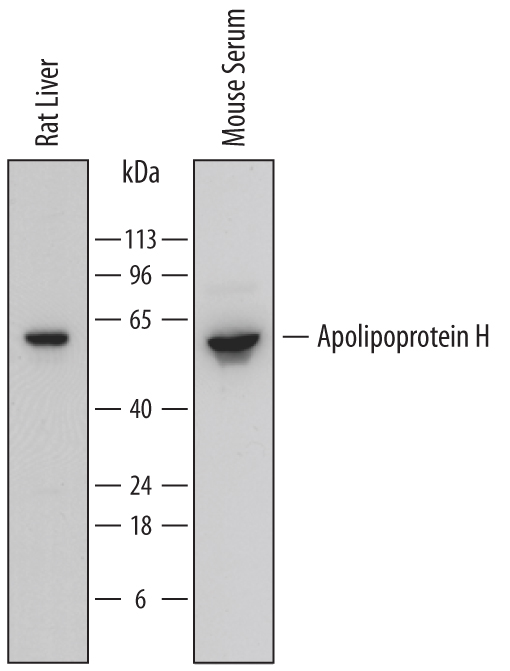Mouse/Rat Apolipoprotein H/ApoH Antibody Summary
Gly20-Cys345
Accession # Q01339
Applications
Please Note: Optimal dilutions should be determined by each laboratory for each application. General Protocols are available in the Technical Information section on our website.
Scientific Data
 View Larger
View Larger
Detection of Rat and Mouse Apolipoprotein H/ApoH by Western Blot. Western blot shows lysates of rat liver tissue and mouse serum. PVDF membrane was probed with 0.25 µg/mL of Sheep Anti-Mouse/Rat Apolipoprotein H/ApoH Antigen Affinity-purified Polyclonal Antibody (Catalog # AF6575) followed by HRP-conjugated Anti-Sheep IgG Secondary Antibody (Catalog # HAF016). A specific band was detected for Apolipoprotein H/ApoH at approximately 50-60 kDa (as indicated). This experiment was conducted under reducing conditions and using Immunoblot Buffer Group 1.
Reconstitution Calculator
Preparation and Storage
- 12 months from date of receipt, -20 to -70 °C as supplied.
- 1 month, 2 to 8 °C under sterile conditions after reconstitution.
- 6 months, -20 to -70 °C under sterile conditions after reconstitution.
Background: Apolipoprotein H/ApoH
Apolipoprotein H (ApoH), also known as beta 2‑Glycoprotein I/ beta 2-GPI, is a variably glycosylated member of the complement control superfamily of proteins with a molecular weight of aproximately 50 kDa (1, 2). Mature mouse ApoH consists of four tandem Sushi/SCR repeats followed by one Sushi-like repeat (3, 4). Mature mouse ApoH shares 76% and 42% aa sequence identity with human and rat ApoH, respectively. Hepatocyte-derived ApoH binds directly to negatively charged phospholipids (5). It circulates as a component of lipoprotein particles and as a lipid-free serum protein (6). ApoH also associates with liposomes and apoptotic cell debris, thereby enabling their renal clearance via Megalin uptake (7, 8). Circulating levels of ApoH are postively correlated with triglyceride-rich lipoprotein (VLDL) components in type II diabetes (9). ApoH inhibits thrombosis by blocking the activation of Coagulation Factor XI but also shows procoagulant activity by inhibiting the activation of Protein C (10, 11). ApoH can be cleaved by Plasmin at Lys317‑Thr318, an action that is enhanced by heparin (12, 13). ApoH cleavage reduces its ability to bind phospholipids and inhibit Factor XI activation but confers the ability to bind Plasminogen (10, 12, 14). Cleaved ApoH also demonstrates antiangiogenic activity, whereas intact ApoH does not (14). The production of antibodies against ApoH is a hallmark of Antiphospholipid Syndrome (APS), an autoimmune disorder that leads to hypercoagulability and recurrent miscarriages (15). ApoH binds to the surface antigen of Hepatitis B Virus and is associated with the development of HBV-induced hepatocellular carcinoma (6, 16).
- Crook, M.A. et al. (2010) Atherosclerosis 209:32.
- Miyakis, S. et al. (2004) Thromb. Res. 114:335.
- Nonaka, M. et al. (1992) Genomics 13:1082.
- Lozier, J. et al. (1984) Proc. Natl. Acad. Sci. 81:3640.
- Wurm, H. (1984) Int. J. Biochem. 16:511.
- Mehdi, H. et al. (1994) J. Virol. 68:2415.
- Chonn, A. et al. (1995) J. Biol. Chem. 270:25845.
- Moestrup, S.K. et al. (1998) J. Clin. Invest. 102:902.
- Castro, A. et al. (2010) Atherosclerosis 209:201.
- Shi, T. et al. (2004) Proc. Natl. Acad. Sci. 101:3939.
- Mori, T. et al. (1996) Thromb. Haemost. 75:49.
- Hunt, J. et al. (1993) Proc. Natl. Acad. Sci. 90:2141.
- Guerin, J. et al. (2002) J. Biol. Chem. 277:2644.
- Sakai, T. et al. (2007) Am. J. Pathol. 171:1659.
- Adams, M. (2008) Semin. Thromb. Haemost. 34:251.
- Jing, X. et al. (2010) J. Cancer Res. Clin. Oncol. 16:1671.
Product Datasheets
Citation for Mouse/Rat Apolipoprotein H/ApoH Antibody
R&D Systems personnel manually curate a database that contains references using R&D Systems products. The data collected includes not only links to publications in PubMed, but also provides information about sample types, species, and experimental conditions.
1 Citation: Showing 1 - 1
-
Gram Negative Bacterial Inflammation Ameliorated by the Plasma Protein Beta 2-Glycoprotein I
Sci Rep, 2016-09-27;6(0):33656.
Species: Mouse
Sample Types: Serum
Applications: ELISA Development (Capture)
FAQs
No product specific FAQs exist for this product, however you may
View all Antibody FAQsReviews for Mouse/Rat Apolipoprotein H/ApoH Antibody
There are currently no reviews for this product. Be the first to review Mouse/Rat Apolipoprotein H/ApoH Antibody and earn rewards!
Have you used Mouse/Rat Apolipoprotein H/ApoH Antibody?
Submit a review and receive an Amazon gift card.
$25/€18/£15/$25CAN/¥75 Yuan/¥2500 Yen for a review with an image
$10/€7/£6/$10 CAD/¥70 Yuan/¥1110 Yen for a review without an image

